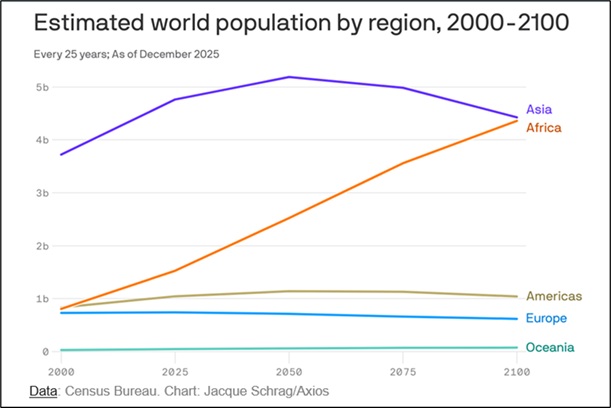by Patrick Fearon-Hernandez, CFA, and Thomas Wash
[Posted: 9:30 AM ET] | PDF
Note to readers: the Daily Comment will go on hiatus after today and will return on January 5, 2026. From all of us at Confluence Investment Management, we hope you enjoy your holiday and have a Happy New Year!
Our Comment today opens with an important summary of the US’s new foreign policy delivered late Friday by Secretary of State Rubio. We next review several other international and US developments that could affect the financial markets today, including signs that the US is ratcheting up its military pressure on Venezuela and a hawkish statement from Cleveland FRB President Hammack, who will be a voting member of the Federal Reserve’s policymaking committee in 2026.
US Foreign Policy: Secretary of State Rubio on Friday provided a detailed briefing on the administration’s foreign policy, confirming several dramatic changes that we think will have big implications for investors. Rubio’s review fleshed out many ideas in the White House’s recent National Security Strategy, which will be the focus of our first Bi-Weekly Geopolitical Report after the New Year.
- Among Rubio’s most important messages was a call for the US to de-escalate tensions with China in favor of “mature” management of the bilateral relationship. According to Rubio, “China is going to be, is, and it will continue to be a rich and powerful country and a factor in geopolitics. Our job is to find opportunities to work together with the Chinese Communist Party and the Chinese government.” Rubio instead stressed threats from Latin America and the US’s dependency on foreign supply chains.
- Rubio had been a leading China hawk before joining the administration, so his statement confirms that the tough-on-China segment of President Trump’s political coalition has now been sidelined.
- Over time, that could create political risk for the White House. As we’ve shown in many reports, the Chinese Communist Party’s political and strategic interests will likely spur it to keep building its overall power — economic, technological, diplomatic, and military, including the massive buildup of its arsenal of nuclear missiles aimed at the US. Strategic logic suggests China’s interests will expand globally, forcing it to work to undermine the US. If China someday is seen to dominate the US, voters in the US could be angered.
- On the other hand, a US decision to pursue détente with China would probably be bullish for US and Chinese stocks. After all, such a decision to tamp down tensions would remove a lot of bilateral geopolitical risks. However, if US foreign policy continues to retrench into a focus on the Western Hemisphere and supply-chain security, the power vacuum abroad would probably ensure continued good returns for foreign defense stocks and precious metals.
Japan: Former Defense Minister Itsunori Onodera of the ruling Liberal Democratic Party said in an interview Sunday that Japan must take a fresh look at its policy to never possess, manufacture, or host nuclear weapons, suggesting that the country is too reliant on the US’s uncertain pledge to defend Japan. That marks the latest in a string of comments by people close to the government that show Tokyo is getting tempted to develop its own nuclear arms, as are South Korea and several key countries in Europe.
China-European Union: Beijing today imposed anti-dumping tariffs of 21.9% to 42.7% on certain dairy products from the EU, claiming EU subsidies on the goods hurt Chinese producers. However, since China opened the dumping probe shortly after the EU opened one against Chinese electric vehicles, Beijing’s action appears to be retaliation aimed at forcing the EU into a compromise on its electric vehicle tariffs. Beijing also has ongoing dumping probes into EU pork and brandy, suggesting EU producers of those products could also be at risk.
Argentina: Deregulation Minister Federico Sturzenegger said in an interview over the weekend that President Milei’s libertarian government will use its increased seat count in the legislature to make much faster progress on key reforms in 2026 than in 2025. According to Sturzenegger, Milei’s government will work toward cutting taxes, reducing government spending, and deregulating the economy, all of which would confirm investors’ greater enthusiasm for Argentine stocks since the autumn elections.
United States-Venezuela: The US on Saturday said it stopped an oil tanker in international waters off the coast of Venezuela, days after President Trump announced a “blockade” of all sanctioned tankers entering and leaving Venezuela. That marks the second US interception of a tanker traveling from Venezuela in the last few weeks. The move suggests the US intends to continue ratcheting up pressure on Venezuelan President Maduro to resign. In turn, that keeps alive the risk of an armed conflict that could be destabilizing to global financial markets.
- The US Coast Guard today is also reportedly trying to chase down another tanker as it moves away from Venezuelan waters. Importantly, the US is justifying some of the interdictions by saying the tankers are flying false flags and aren’t necessarily under formal US sanctions.
- In any case, the rising tensions are buoying precious metals prices so far today. Near gold futures are currently trading at $4,430.2, up 1.3% for the day.
United States-Denmark-Greenland: President Trump yesterday named Louisiana governor Jeff Landry to be his special envoy for Greenland, after which Landry issued a statement saying that he will be honored to work “to make Greenland a part of the US.” In response, the Danish government called in the US ambassador to issue a formal protest. The appointment suggests the US administration now intends to renew its pressure on Denmark to cede Greenland. In turn, that will likely further worsen US-EU tensions and could weigh on EU stock prices.
US Monetary Policy: In an interview with the Wall Street Journal, Cleveland FRB President Beth Hammack said she sees no need to change interest rates for several months now that the central bank cut rates at its last three meetings. According to Hammack, there is still too much risk of resurgent price inflation to cut rates again at the moment. Hammack’s statement is consistent with our view that while the Fed will likely cut interest rates more aggressively in 2026 than in 2025, most of the cuts will likely come in the second half of 2026.
US Fiscal Policy: In a big policy reversal for Gov. Gavin Newsom, the California state Medicaid program said it will stop accepting adults with “unsatisfactory” immigration status and will require immigrants already in the program to pay a $30 monthly premium to keep their health coverage starting in mid-2027.
- The move reverses a 2022 policy of providing state-supported healthcare to all low-income Californians on the belief that it would reduce costly emergency-room visits and be good for the economy. However, the policy sparked rapid cost increases and strong pushback from conservatives.
- The new move will likely help reduce California’s healthcare costs but will put added economic pressure on immigrants, potentially pushing many to leave the country and further crimping the US labor market.
US Aerospace and Aviation Industries: The Wall Street Journal today carries a long article highlighting the growing incidence of “fume events” on airliners, where toxic fumes from synthetic engine oils and other fluids are siphoned into the cabin. The article shows how the fumes sometimes lead to serious illness or even death, leading to big lawsuits against firms such as Boeing. The article, which follows an initial report by the Journal in September, could spark increased lawsuits, regulation, and reputational damage for aircraft makers and airlines.





